According to Gartner, 95% of businesses collect customer feedback in some form. This is only natural! It is, after all, a tried and true method of improving several aspects of a business. User experience, customer satisfaction, the sales funnel. The list can easily go on.
One of the most common ways (and best, in our humble opinion) of doing so is by conducting a survey. It’s flexible, it gives you actionable insights and it’s an easy way of reaching your target audience.
So far, so good. But here comes the difficult question: What kind of survey should you conduct?
Don’t worry! In this blog, we’ll deep dive into different survey examples for you. We have even included five great survey examples from real brands.
This article covers:
- What is the difference between a survey and a questionnaire?
- Types of survey examples
- What types of online surveys are there?
- Common survey metric examples
- 6 great survey examples from real brands
First things first. Let’s start with an easy question before we go any further.
What is the difference between a survey and a questionnaire?
These two words are often used interchangeably, but there is actually a clear difference. A questionnaire is a set of questions, while a survey is the entire process of collecting and analyzing the data that comes in from your questionnaire.
In other words, a questionnaire is a research tool, while a survey is a research method that usually includes a questionnaire.
Examples of survey types
There are an endless amount of survey types. Which one you should choose depends on what you want to get out of your research.
Today, online surveys are easily the most common survey type. This is because:
- Most businesses have an online presence
- Online communication is already the most common way of interacting with customers and users
- Online surveys make it possible to reach a large audience in a quick and affordable way
- Automated analytics, with the help of survey software like Mopinion, make it easier to turn feedback data to actionable insights
For these reasons, this blog will focus on online survey examples.
What types of online surveys are there?
Online surveys can be conducted in a number of different channels and ways. These are the three most common examples of online surveys:
Website surveys
If you are trying to reach a broad audience, a website survey is your safest bet. Especially if your website gets a lot of traffic.
Are you collecting general feedback? Then make the survey visible on all your pages by implementing a feedback button.
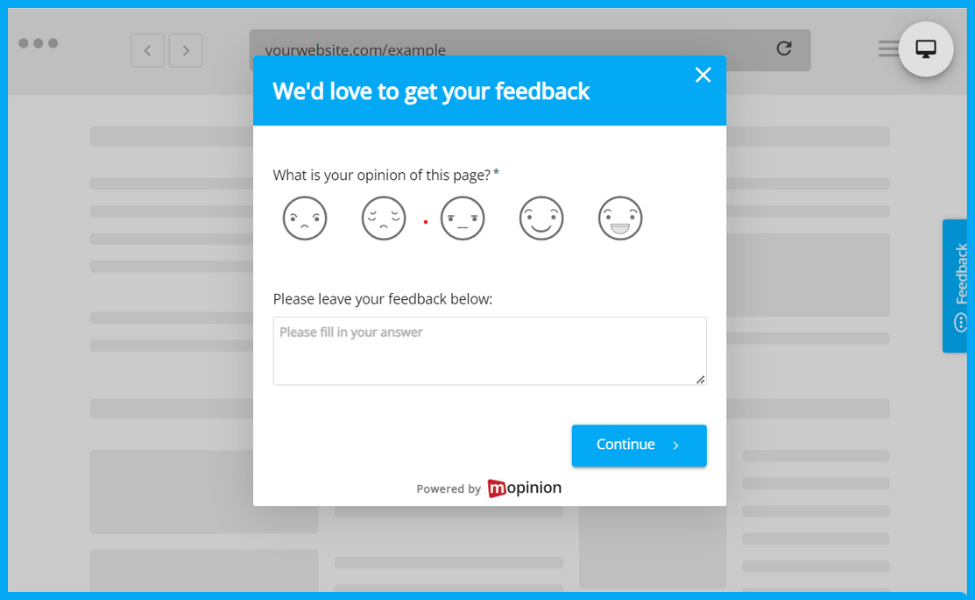
Would you rather gather feedback about a specific feature or page? No problem. With the right survey software you can easily direct when, where and to whom you show your survey. This is known as triggering.
Trying to find the right software for you? Read our article about the best survey software.
Mobile surveys
These can either be launched on your mobile website, or in-app with a SDK. In general, they work similarly to website surveys. You might, for example, want to run your survey on both desktop and mobile to make sure you reach the broadest audience possible.

A mobile survey can, however, also be helpful if you are trying to get feedback that specifically concerns your app. Like special features or how the navigation works in-app.
Email surveys
This type of survey has many different benefits depending on how it is conducted. It’s the perfect place to ask about a customer journey experience. For example, after a successful delivery or at the end of a customer service interaction.
You can also put in a question at the end of your newsletter or in an email campaign to find out what your readers think about your content.

Email is also the perfect way to conduct a segmented survey as you can easily select who you send it to.
Common survey metric examples
Aside from choosing the right channel for your survey, you should also consider if you want to use a specific metric. These are beneficial when you want to discover more aboutyour general customer satisfaction or loyalty levels.
These are the three most common survey examples based on metrics.
NPS surveys
NPS surveys (Net Promoter Score) are used to measure customer satisfaction and loyalty. Typically, they are conducted by asking the target group “How likely are you to recommend [insert brand/product/service]?” along with a score from 0 to 10. Based on the results, an NPS score, ranging from -100 to +100, is determined.
NPS is also the most popular metric. According to Fortune, two thirds of the 1000 biggest companies in the US conduct some kind of NPS survey.
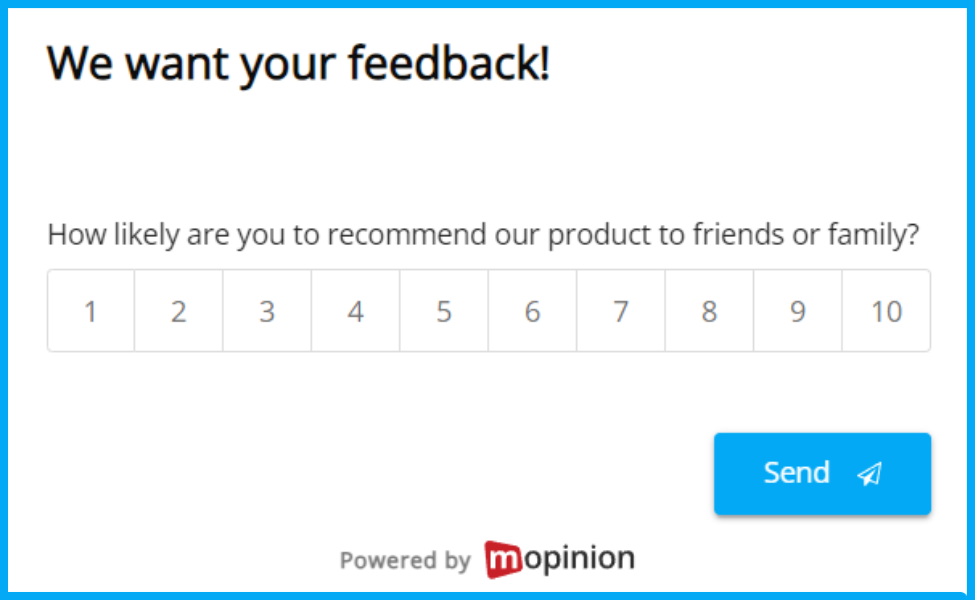
CSAT surveys
Customer Satisfaction surveys, also known as CSAT surveys, measure exactly what it sounds like: your general customer satisfaction.
This type of survey can be conducted in a few different ways, but usually, you ask your customers to rate you on a scale. Based on the answers you calculate a percentage. The result is your CSAT score.

CES surveys
You calculate your Customer Effort Score (CES) by asking your customers to rate you. The difference between CSAT and CES surveys is that the latter focuses on the effort it took for the customer to achieve a certain goal, rather than your brand as a whole.
Don’t forget to also check out our blog on how to write good survey questions (complete with 80 examples). Here you can find more information on what kind of questions to ask based on survey metrics and other goals.
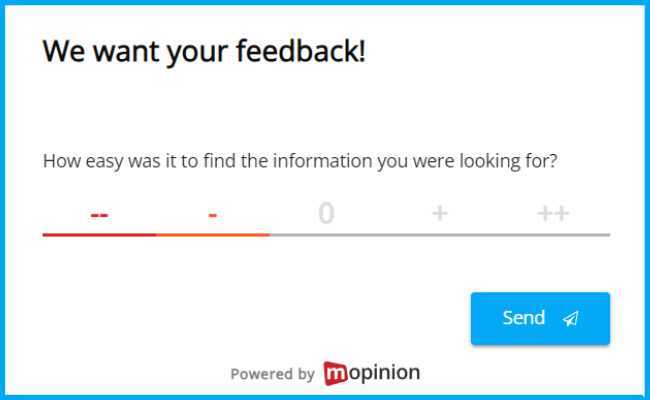
6 great survey examples from real brands
Reading about surveys can be helpful, but it’s always easier to get inspiration from what others are doing. That’s why we have gathered these survey examples from real life. Check out how some of the top brands out there collect customer feedback!
Website survey: Vodafone – Conversational feedback
Conversational surveys have several benefits compared to traditional ones. They are more personal and they allow you to collect real-time feedback. This makes it easier to find pain points and discover meaningful wishes from your customers.
In the example below, Vodafone is trying to gather information that can help them improve their customer experience.
The fact that Vodafone opens the chat by telling the customer that they will only ask up to three questions is also a great tactic to improve the response rate. It indicates that the survey won’t take up a lot of their time.
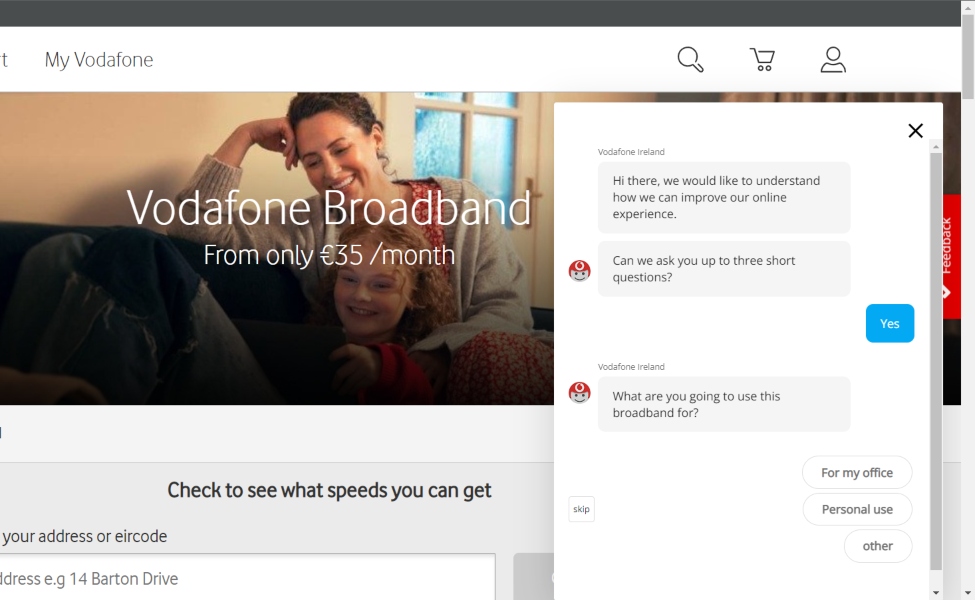
Website survey: Calvin Klein – CSAT survey
This customer satisfaction survey from Calvin Klein does a few things very well. They start off by asking about the customer’s general experience. This is of course nice information to have, but without further context, it’s next to impossible to make any changes that improve the customer experience.
The follow-up question, asking for more information, together with the possibility of adding a screenshot, creates more actionable insights.
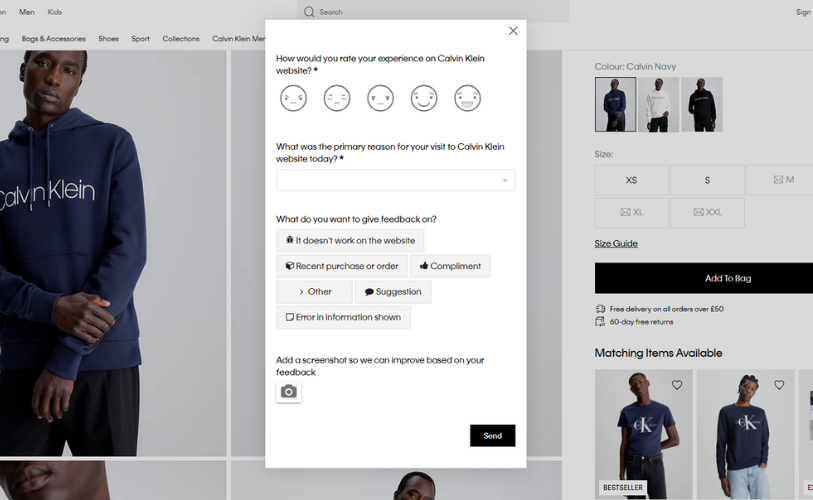
Email survey: DHL – CSAT survey
DHL has the perfect example of a CSAT survey. It is included in an email informing the customer that their package has been delivered. As the recipient is likely to open this email, it makes it the ideal time to gather feedback on the delivery service.
The questions asked are also very easy to answer, which improves the response rate of the survey. The shorter it is, the better.
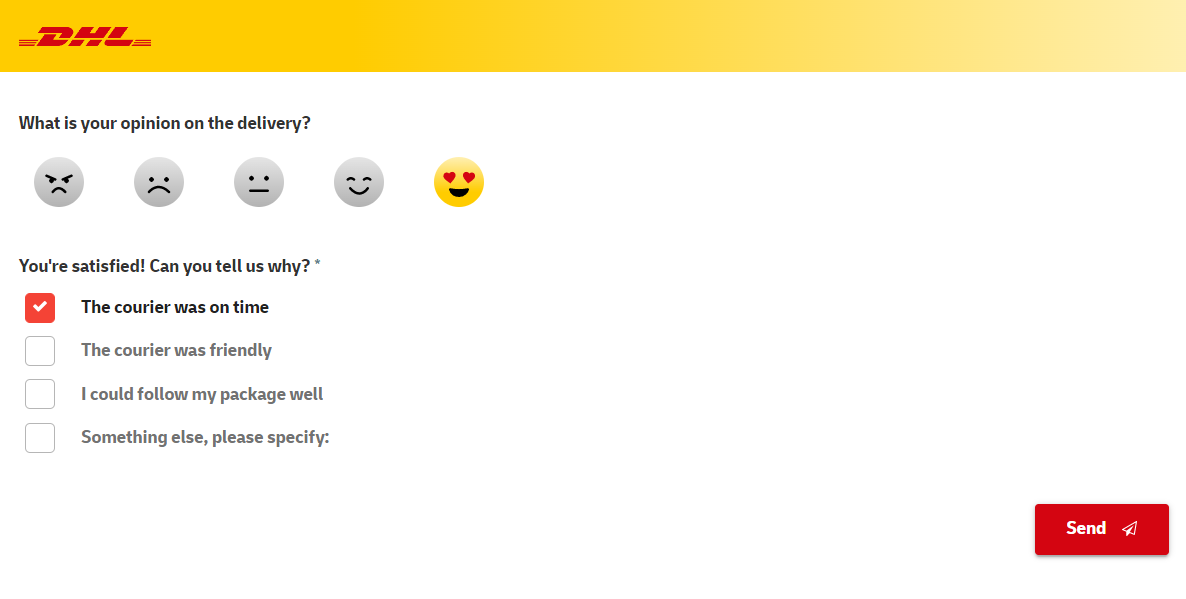
Email survey: Beerwulf – CSAT survey
This email from Beerwulf is a great example of how you can improve your marketing emails by asking for feedback. It is also perfect for newsletters or any other kind of communication you send out using email.
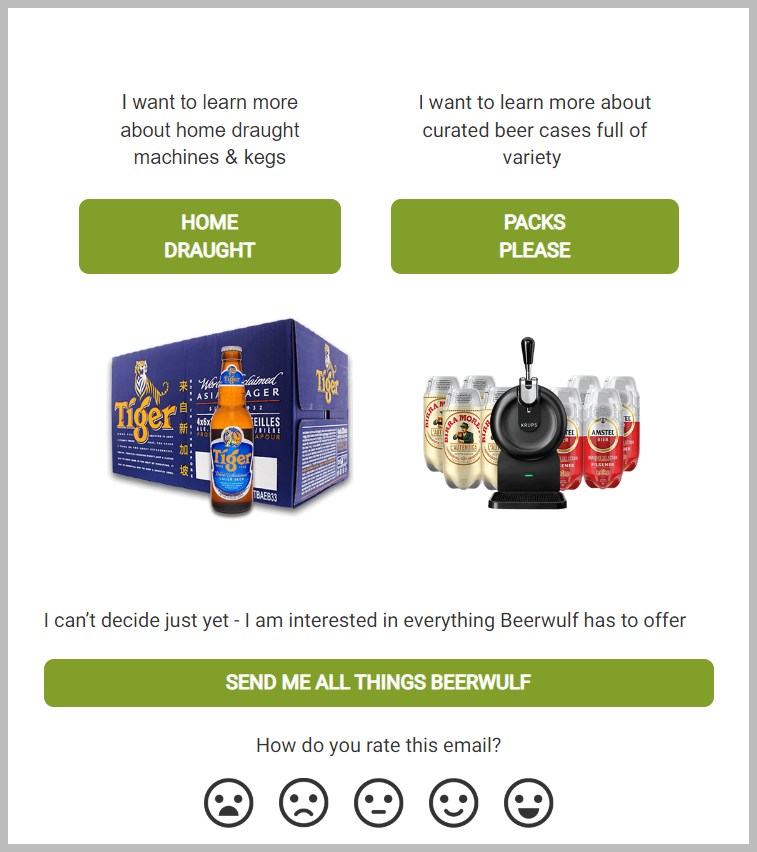
In-app survey: Vodafone Ziggo
In this survey, Vodafone Ziggo is doing research about an upcoming new feature. This feedback gives insights into the biggest interests of the customers, as well as the reason why they are interested in the feature.
This is a great step to add to any product development process. It shows you what the unique selling point of the feature should be and what the customer considers to be important.
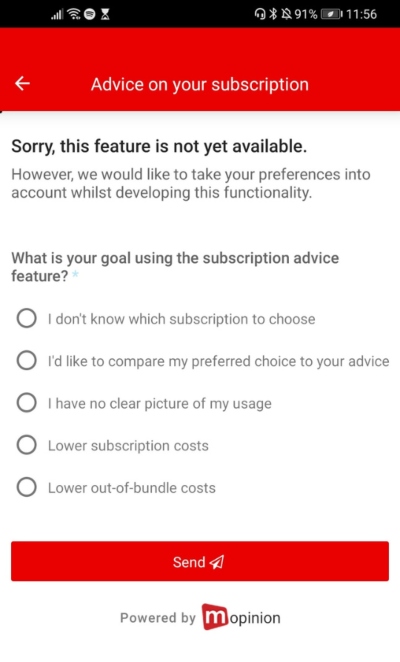
Website survey: TomTom – NPS survey
This survey from TomTom is a great example on how you can address two different topics in the same feedback form. At first, TomTom asks the customer their general feedback on the page that they are on. Then they move on to the NPS survey.
Additionally, it is always a good idea to ask for follow-up feedback when you ask your customers to rate you, as it gives you actionable feedback.

Create any survey you want with Mopinion
Are you in the process of conducting an online survey? Then you’ve come to the right place. Mopinion is a powerful customer feedback software that helps you create beautiful surveys for your website, your email campaigns or your app. But that is not all.
Mopinion helps businesses gather actionable insights, by automatically collecting and analysing your survey responses in dashboards (which are completely customisable, by the way).
Among other things, we offer:
- An easy-to-use interface
- Build customisable forms with drag-and-drop functionality
- Conversational, chat-like feedback forms
- Automated charts are generated as soon as you build your feedback form
- Customisable data dashboards
- Self-hosted surveys: No need for Javascript to set up your surveys
- Single Sign-On for Microsoft Azure
- Native SDK (Android and iOS): Fully native feedback on your app. No redirection is needed.
Ready to see Mopinion in action?
Want to learn more about Mopinion’s all-in-1 user feedback platform? Don’t be shy and take our software for a spin! Do you prefer it a bit more personal? Just book a demo. One of our feedback pro’s will guide you through the software and answer any questions you may have.







